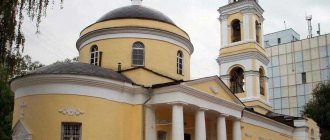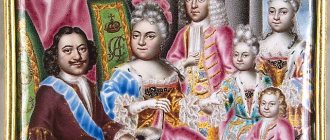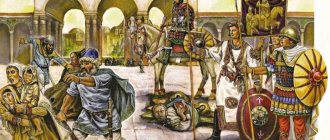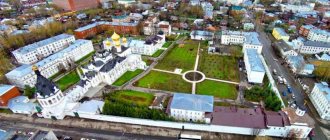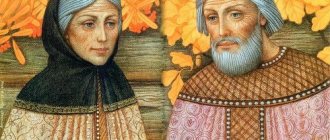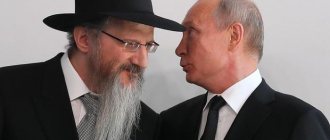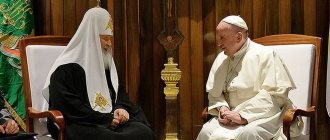- The collapse of autocracy - the execution of the Royal Family
- Mourn and pay tribute - how the sufferers were remembered
- Heavenly rank and earthly relics - worship of rulers
- Prayer to the Royal Passion-Bearers
The tragic death of the All-Russian Emperor and his loved ones shook the country. Some rejoiced, considering this event a harbinger of a new order; others sadly mourned Nicholas II, his wife Alexandra Feodorovna, the heir to the throne Alexei and the Grand Duchesses Olga, Tatiana, Maria and Anastasia. The church did not stand aside either - and how exactly the holy Royal Passion-Bearers were venerated, you will learn from our article!
Why was the royal family canonized?
Historical facts do not allow us to speak of members of the royal family as Christian martyrs. Martyrdom presupposes for a person the opportunity to save his life, albeit through direct renunciation of Christ. The royal family had no such choice. They were killed precisely as the sovereign's family. The people who did this were quite secularized in their worldview and perceived them primarily as a symbol of the imperial Russia they hated.
Therefore, the family of Nicholas II is glorified in the rite of passion-bearing, which is characteristic specifically of the Russian Church. This rank is traditionally used to canonize Russian princes and sovereigns who, having a firm faith in God, imitating Christ, patiently endured physical and moral suffering or death at the hands of political opponents.
Five reports devoted to the study of the state and church activities of the last Russian sovereign were submitted to the Synodal Commission for the Canonization of Saints. The commission decided that the activities of Emperor Nicholas II in themselves do not provide sufficient grounds for both his canonization and the canonization of his family members. However, the reports that determined the final - positive - decision of the Commission were the sixth and seventh: “The Last Days of the Royal Family” and “The Church’s Attitude to Passion.” “Most witnesses speak of the prisoners of the Tobolsk governor’s and Ipatiev Yekaterinburg houses,” the report “The Last Days of the Royal Family” emphasized, “as people suffering, but submissive to the will of God. Despite all the mockery and insults they suffered in captivity, they led a pious life and sincerely sought to embody the commandments of the Gospel in it. Behind the many sufferings of the last days of the royal family, we see the all-conquering evil of the light of Christ’s truth.”
It is the last period of the life of the members of the royal family, spent in captivity, and the circumstances of their death that provide serious grounds for glorifying them as passion-bearers. They realized more and more that death was inevitable, but they managed to preserve spiritual peace in their hearts and at the moment of martyrdom they acquired the ability to forgive their executioners. Before his abdication, the sovereign said to General D.N. Dubensky: “If I am an obstacle to the happiness of Russia and all the social forces now at its head ask me to leave the throne and pass it on to my son and brother, then I am ready to do this, I am ready even not only the kingdom, but also to give one’s life for the Motherland.”
A few months later, Empress Alexandra wrote in captivity in Tsarskoye Selo: “How happy I am that we are not abroad, but with her [the Motherland] we are going through everything. Just as you want to share everything with your beloved sick person, experience everything and watch over him with love and excitement, so it is with the Motherland.”
Why was Nicholas II canonized by the Russian Orthodox Church?
Our children and grandchildren will not be able to even imagine the Russia in which we once (that is, yesterday) lived, which we did not appreciate, did not understand - all this power, complexity, wealth, happiness...
Writer Ivan Bunin, awarded the Nobel Prize, 1919
1. Introduction: the brand of my soul
As a child, I collected stamps, and one of them depicted Nicholas II. His face touched my heart, and 50 years ago, in 1968, on the 50th anniversary of his martyrdom, I, living in my hometown near Colchester, began to study Russian on my own. Soon he found his spiritual home in the Russian Orthodox Church. I discovered that the date of execution of the royal family was only one day behind my birthday and that Nicholas II and my great-grandfather were born in the same year - 1868. While studying Russian at Oxford, I learned that Felix Yusupov, one of the murderers of Grigory Rasputin, had studied at the same college as me, and that the first Russian Orthodox priest at Oxford was Father Nikolai Gibbs, the teacher of Tsarevich Alexei. I knew several people who knew him well personally. In the 1970s, I went to study at the Russian Seminary in Paris, where I met the last emigrants who knew the royal family. Later, in 1995, I saw an interview with the oldest inhabitant of the planet, Jeanne Calment, a simple French woman who lived to be 122 years old. She admitted that the most terrible event in her life was the brutal murder of the Russian Imperial Family - and her opinion was shared by many others.
2. The real Tsar Nicholas
In the 1970s, the Russian Orthodox Church Abroad was finally preparing to glorify the Russian new martyrs, including the royal family. If what Western and Soviet propaganda insisted that Nicholas II was a “weak, stupid, incompetent reactionary” were true, then he would not be a saint. So I looked at the five most common allegations against him.
A. The king was weak
If Nicholas II was weak, then why did he not agree with his father's choice of bride? This is what Pavlov wrote about the envious older grand dukes who unsuccessfully tried to manipulate the young 26-year-old tsar after the unexpected death of his father Alexander III, which left many unresolved problems: “Every attempt to influence the sovereign ended in failure.” If Nicholas II was weak, then why was he so passionate about the construction of the Trans-Siberian Railway and the development of relations with Asia (for which many criticized him, especially the traitor-schemer Minister of Finance Witte)? The tsar had a premonition of a big war, which is why on the monarch’s birthday in 1899, on his initiative, a Peace Conference was opened in The Hague, for which he was initially ridiculed. In 1898, Admiral von Tirpitz wrote that Nicholas II was “a fearless man with muscles of steel,” and French President Emile Loubet in 1901 called him “a man of exceptional willpower.”
By 1903, the tsar had gained experience, and now his opponents accused him of “stubbornness,” thereby proving his weakness! In addition, the sovereign insisted on the canonization of St. Seraphim of Sarov, which was opposed by the insensitive bureaucratic bishops. By the way, the long-awaited heir to the throne, Tsarevich Alexei, was born through the prayers of St. Seraphim. In addition, the emperor stood up against the Japanese aggression unleashed by the West and himself insisted on concluding peace on favorable terms. This was followed by the Tsar’s decisive suppression (despite the weak-willed authorities) of Japanese-funded terrorism, which killed 9,000 people. A weak king would never have become an outstanding reformer and would have fallen long before the war with the Kaiser began.
If the emperor had been weak, he would not have removed his incompetent traitor uncle, bully and anti-Semite Grand Duke Nikolai Nikolaevich from the post of supreme commander. (The Tsar later wrote about him: “They all betrayed me, especially Nikolasha”). This happened in August 1915, at an extremely difficult moment for the Russian army. “My decision is unshakable,” the sovereign said to the ministers, 8 of whom he removed for refusing to obey him. Nicholas II was a courteous diplomat, possessed amazing restraint, and was evasive with those who meddled in his affairs; but he was not weak, for he always moved forward towards his intended goal. It would not take a cunning conspiracy of elites to overthrow a weak monarch. This is what Grand Duke Alexander Mikhailovich wrote in the 16th chapter of his memoirs, confirming the opinion of the majority:
“The Romanov throne fell not under the pressure of the forerunners of the Soviets or young bombers, but bearers of aristocratic families and court nobility, bankers, publishers, lawyers, professors and other public figures who lived on the bounty of the Empire... Descriptions of the anti-government activities of the Russian aristocracy and intelligentsia could amount to a thick volume that should be dedicated to Russian emigrants mourning the “good old days” on the streets of European cities.”
For those who have doubts, we recommend reading E. Alferyev’s book “Emperor Nicholas II as a Man of Strong Will” or the sermon of Patriarch Kirill, delivered this year in Yekaterinburg.
B. Nicholas II is personally responsible for Khodynka
The stampede on Khodynka Field in Moscow, which occurred on May 18, 1896 during celebrations in honor of the coronation of Nicholas II, as a result of which 1,389 people died, was not the fault of the tsar. Like other stampedes, from the one that occurred during the 50th anniversary of Queen Victoria's reign in London in 1887 (with 2,500 deaths) to the Mecca stampede of 2015 (with 2,262 deaths), " Khodynka" was a terrible tragedy. It was caused by an unheard of crowd of a million people at that time. Excited people were not waiting for free coronation mugs made in Birmingham, but for non-existent “gifts”, the distribution of which was rumored by irresponsible journalists. The compassionate king paid the families of the victims amounts of money equal to a year's salary and paid funeral expenses. The culprits—the incapable administrators who tried to mar his reign—were duly removed from their positions. In essence, the culprits were the corrupt bureaucrats and bankrupt aristocrats whose ancestors had tried to kill or overthrow Nicholas II's predecessors, Paul I and Alexander I.
V. The Tsar organized pogroms
The word "pogrom" actually means "mass riots." Its cause is economic envy. Examples include the events of 1895-96, when Turkish fanatics massacred 50,000 Armenians; 1903-04, when Albanians killed hundreds of Kosovo Serbs; February 18, 1905, during the Armenian-Tatar massacre in Baku. This happened for hundreds of years both in Ireland, where rich Protestant colonists and poor Catholic Irish killed each other, and in the United States, where the war between blacks and whites continued. There was not a single anti-Semitic pogrom in Russia, but terrible pogroms took place in Vienna and Berlin around 1900. Other pogroms, often initiated by the Jews themselves, took place in the 13 protected, Jewish-majority western provinces incorporated into the Russian Empire from 1791. 90% of the empire's five million Jewish community lived there (60% of all Jews living in the world at that time) - most of them were poor, but some were super-rich and controlled economic life.
Riots began in the 1880s and ended in 1907. They were condemned by the Church - the righteous saint John of Kronstadt called them “satanic.” At its peak, from 1903 to 1907, 1,622 people died in unrest in what is now Poland, Lithuania, western Ukraine and Moldova, where 50% of the population was Jewish and 50% local. Of the total number of dead, 711 were Jews, the rest were mostly Catholics. The same number of Jews died every 4.5 hours (and the same number of Soviet citizens died every hour) at the hands of Western invaders from 1941 to 1945. The Tsarist government had to constantly intervene and intervene between both sides, doing this as impartially as possible, which is confirmed by Professor Roger's research.
Despite emigration, the Jewish population in the empire grew sixfold over 120 years, and by 1917, 60,000 Jews lived in Moscow alone. The absurd propaganda that Tsar Nicholas II was supposedly an anti-Semite is easily refuted by the fact that the sovereign built large synagogues in Moscow, Gomel, Batumi, Kyiv, Kharkov and Smolensk - the ruler took care of everyone. The Emperor (as well as the rabbis he consulted) was concerned about the many young Jews who had lost their faith and become criminals or terrorists. It should be noted that from 1901 to 1911, over 17,000 non-Jews died in terrorist attacks in Russia, although this was hardly mentioned in the press. The worst anti-Jewish pogroms were carried out by Ukrainian nationalists in 1919; by that time the king was already dead and could not pacify the fanatics. There were no media publications about these pogroms.
G. The Tsar is to blame for “Bloody Sunday”
“Bloody Sunday” (an expression coined by the Times newspaper) occurred on January 9, 1905, when a crowd of 3,000 people led by social revolutionaries marched towards the Winter Palace. The terrorist leaders, Rutenberg and Gapon, wanted to kill the tsar, but the latter was not there and he knew nothing about what was happening. According to their plan, terrorists and snipers, setting fire to and looting private property, hiding behind stolen icons and using deceived demonstrators as human shields, opened fire on the troops protecting the frightened residents of St. Petersburg. As a result of this and other incidents that occurred that day, 130 people died, including police officers. The Tsar, who was not even informed about the demonstrations, fired two ministers and the head of the police department.
D. Rasputin
Grigory Rasputin was neither a madman, nor a monk, nor a priest, nor a hypnotist, nor a member of a sect, nor a rowdy, nor a horse thief, nor a person who interfered in politics. In fact, he was a pious married peasant with three children who, after a vision of the Blessed Virgin Mary, visited the Holy Land and Athos (where his uncle was a monk). He learned the Gospel by heart, became an ascetic and a man of prayer, fell in love with monasteries and acquired the gifts of clairvoyance and healing (miracles occurred even after his death). Gregory distributed the money he received to others and donated it for the construction of a temple in his native village. He died in poverty. The surname “Rasputin” means “one who stands at the crossroads - at the crossroads” - a very suitable surname for someone who was killed by the “first salvo of the revolution” on the eve of the fateful 1917.
According to a study of open Russian archives (a biography of Bokhanov and 9 volumes of Fomin), Rasputin, who founded a temple, a school and a temperance society in his village, was not a dissolute drunkard (unlike his slanderers and murderers), but a victim of their envy and slander. Why? Because the slanderers wanted to discredit the monarchy through him. As Prince Zhevakhov wrote in his memoirs, if these people had not slandered Rasputin, they would have found someone else. His murder frightened Russian peasants, who felt that corrupt bureaucrats and aristocrats would separate them from their beloved Tsar.
3. Russian Empire under Tsar Nicholas II.
During the 23 years of the reign of the last Russian Tsar, the population of his empire, which accounted for a sixth of the landmass, increased by almost 50% from 122 million to 180 million, which amounted to 10% of the world's population. With the development of medicine, the birth rate was 48 per 1,000, much higher than in any other European country. According to Mendeleev's calculations, the country's population would have grown to 400 million by 1950, and would have reached 1.25 billion by 2050. Thanks to the tsar's eleven radical reforms, including the peaceful settlement of Siberia, which he saw as "Russian America", the empire experienced an economic boom and became the third largest economy in Europe after Great Britain and Germany.
Coal production increased by 430%, sugar by 400%, railway length by almost 150%, iron ore production by 140% and oil by 100%. From 1893 to 1913, the rate of income growth increased 6-fold to 9% (higher than any other country). The gold reserve increased by 250% and became the second largest in the world. After visiting Russia in May 1913, French economist Edmond Thery predicted that if the pace of development continued as in 1900-12, then by 1950 Russia would dominate Europe politically, economically and financially. In 1913, manufacturing output in Russia reached 6.8% of the world's; during Soviet times it rapidly fell and returned to its previous level only in 1937 (and then thanks to slave labor). Only the Russian Empire could stop the West in its quest for world domination. Consequently, this new economic power had to be destroyed, and for this the king had to be overthrown. Since Japan failed in 1904, others tried in 1914.
In 1861, 160 years after the introduction of slavery, which was alien to Russia, it was abolished; a little later, slavery was abolished in the USA - only here it required sacrificing the lives of half a million people. As for Western Europe, it must be said that in the 19th century most people lived like slaves; The USSR reintroduced slavery, calling it “collectivization,” killing millions of its inhabitants through artificially induced famine and driving millions to alcoholism. Tsar Nicholas (despite all the excuses) appointed Stolypin as prime minister to carry out his 1906 agrarian reform, making peasants landowners and creating a “great Russia.”
In 1906, he began to tax the rich and distribute land to the poor. By 1914, 80% of arable land belonged to peasants - the Tsar himself transferred 100 million acres to them. All this angered both the power-hungry revolutionaries and the feudal nobility; they conspired against the tsar, and in 1911 Stolypin was killed. As a result of reforms, the empire became the breadbasket of all of Europe, and in 1913 its wheat harvest was 28% higher than that of the United States, Canada and Argentina combined. In 1913, Russian eggs accounted for 50% of world exports, butter 70%, and flax 80%. Russia accounted for 25% of the world's wheat, oats and potatoes, 40% of barley and 50% of rye.
This was accompanied by rapid technological progress. The world's first helicopter, a four-engine airplane (in both cases thanks to Sikorsky), a monoplane, a seaplane (under Tsar Nicholas, 6,300 aircraft were built in Russia, and the Russian air force in 1914 was the strongest in the world), an airship, an aircraft carrier were created , parachute (the first in the world, invented by Kotelnikov), rocket (Tsiolkovsky in 1911), submarine (there were 70 of them by 1917). People trained under “tsarism” created weapons, thanks to which the generals trained under the same “regime” won the Great Patriotic War. The first electric railways, telegraphy, radio (Popov in 1895), telephone and television appeared (Rosing in 1911 and Zvorykin in exile). There were enormous developments in fields such as petroleum distillation, chemistry (economist and chemist Mendeleev), atomic energy (Vernadsky in 1910), physiology (Pavlov), medicine, zoology, geology, oil pipelines and hydroelectricity. Many roads were built for 48 Russian automobile factories, the construction of a metro in Moscow and the complete electrification of the empire were planned.
In 1897, when inspectors had already appeared in factories, the working day in Russia was the shortest in the world; in 1906 it was from 8 to 10 hours, and Sundays were days off. Social insurance was introduced in 1912. Since 1903, disabled workers received a pension equal to two-thirds of their salary. By the 1890s, Russia had completely free healthcare (50 years before the UK, while the US had still not achieved this!). There were 8,110 hospitals and 22,772 doctors. The average life expectancy was 68 years (the same as after 74 years of the USSR's existence). Alcoholism rates were among the lowest in Europe, with alcohol consumption at 7 liters per person per year. In 1912, American President Taft said: “Your Emperor has created such perfect labor legislation as no democratic state can boast of.”
Free primary education was introduced in 1908 (albeit a generation later than in Western Europe); and thanks to the radical reforms of Tsar Nicholas in 1893-1913, spending on education increased by 628%, reaching 20% of the government budget in 1914 (twice more than in France!). By 1912, 130,000 schools were already operating. If during the 1897 census it turned out that literate people in the empire were 27.8%, then by 1916 there were already 56%, and illiteracy could practically disappear by 1926, since Tsarist Russia planned to introduce compulsory secondary education in 1920. At that time, over 39,000 students were studying at Russian universities, while in Britain there were 5,000; there were more women with higher education than anywhere else in the world; in 1900, a third of the students at the Sorbonne University in Paris were Russian. In 1914, half of Moscow State University students studied for free. In 1908, 70 million books were published in Russia. In 1914, the empire published more than 32,000 book titles—as many as the United States, Britain, and France combined.
In 1905-06, at the height of the wave of terrorism, there were only 77 criminals per 100,000 inhabitants of the Russian Empire, compared with 132 in the United States, 429 in Britain and 853 in Germany. In 1914, there were 7 times fewer police officers in Russia than in Britain and 5 times fewer than in France. And after that the Bolsheviks called the empire a “police state”! Jury trials in Russia were a source of admiration. The number of civil servants in the empire was small compared to other countries.
Another great achievement was temperance: by 1914, alcohol consumption had dropped by as much as 16% thanks to the sovereign's introduction of Prohibition, and by 1915 it had dropped to 0.2 liters per year per capita.
4. The Tsar in periods of peace and war.
As the eldest imperial son and heir to the throne, Nicholas II was carefully prepared for the role of ruler. He received an excellent education - he studied law and military affairs; spoke five European languages fluently; knew the history of Europe thoroughly; had an amazing memory and traveled extensively throughout Europe and Asia. Dr. Botkin called the passion-bearer “the most intelligent and educated person I have ever met.” Called the “apostle of peace,” the sovereign in 1898 achieved the start of international negotiations on arms limitation in The Hague, to the surprise of belligerent Western leaders. The Hague Peace Conferences of 1899 and 1907, convened at the initiative of the Emperor, ultimately served to establish the International Court of Justice, the League of Nations and the UN.
Japan's attack on Port Arthur in 1904 without a prior declaration of war was comparable to the attack on Pearl Harbor in the United States, but, ironically, the Japanese fleet was essentially created by Britain and financed by the United States. The peace-loving empire, whose military spending was only a quarter of that of Western Europe and Japan, was not technically prepared to fight a war 6,000 miles from its capital. It would hardly be fair to blame the Tsar for Japanese aggression. The outdated Russian fleet lost to the onslaught of the newest Japanese dreadnoughts, but Russia would have won the war if it had continued. It should be noted that this was before the post-war reforms, including the construction of a modern fleet and armored trains. In any case, the peace terms dictated by the strong-willed sovereign (despite all the “advisers”) were accepted with relief by bankrupt Japan, which asked for peace just 18 months after the start of the war.
Ten years later, the Tsar warned Franz Ferdinand (who was against the Germans and supported the Slavs) not to pay a visit to Sarajevo, annexed by Austria. This devout Catholic monarchist and his Czech wife were shot dead by a Bosnian Marxist teenager, something the Kaiser had foreseen three weeks before the tragedy. According to Franz Ferdinand's son Prince Ernst, the militarists in Vienna, Berlin and Budapest were using the Yugoslav atheist to eliminate the peace-loving Archduke before he ascended the throne. This was the long-awaited reason for the start of the war, for which Prussian Germany, armed to the teeth, had been carefully preparing for a long time. If there had been no Sarajevo, Germany would have found another excuse, as can be seen from the crises of 1908-09 and 1912, when only thanks to the efforts of the Russian Tsar, rivers of blood did not flow in Europe.
Nekrasov's research proves that Nicholas II was an outstanding commander who made decisions and then gave instructions to his generals. Once he became Supreme Commander, the army's morale rose, discipline improved greatly, and it was finally properly equipped and armed. Victories followed, the most famous of which was the famous Brusilov breakthrough of 1916, an offensive led by Nicholas II. The losses of Germany and Austria-Hungary, who had twice as many troops on the eastern front as on the western front, were almost twice the losses of Russia.
The myth that the Tsar and Tsarina were supposedly “pro-German,” propagated by Lloyd George (who later admired Hitler!) and the British spy Samuel Hoare (who later collaborated with Hitler in Munich), turned out to be, indeed, just a myth. The queen, the granddaughter of Queen Victoria, did not like the Prussian militarists for the enslavement of her native Hesse, and the emperor’s mother, a Dane, could not forgive them for the annexation of Schleswig.
Ironically, we now know that the slanderers who claimed that the Tsar and Tsarina allegedly sought a separate peace with Germany actually sought it themselves, especially the traitor Lenin, who was sponsored by Germany.
If there had not been a coup staged by the elite in February 1917, then victory in the war would have been guaranteed - so thought Churchill and others. What would the victory have led to if it had happened a whole year before November 1918?
First of all, millions of lives would have been saved in blood-soaked France, where “lions were led by donkeys.” It would have been possible to completely avoid the deaths of Americans. As the French ambassador Maurice Paleologue noted on November 21, 1916, Vienna and Berlin should have been liberated by Russian troops in 1917 (and not after the bloodbath in 1945).
The peoples of Germany would be freed from the curse of militarism and the humiliation of the Treaty of Versailles (“This is not peace, but a truce for 20 years,” as Marshal Foch predicted). The Kaiser would have been sent into exile. Schleswig would be returned to Denmark, Alsace and Lorraine to France, and Silesia to Poland. German states such as Hanover, Hesse, Bavaria and Saxony, having regained their independence, could once again become centers of culture, music and poetry, as they were before the Second Reich in 1871. Accordingly, there would not have been a Third Reich of Hitler, who called the Revolution of 1917 “the pointing finger of providence”, because thanks to it the Nazi seizure of power in Germany became possible.
The Austro-Hungarian Empire would split into a demilitarized confederation, as Franz Ferdinand had planned. Together with Poland, which would finally be liberated by the Russian army (as promised by Nicholas II in 1914), it would become a group of independent Catholic states. Slovenia and Croatia, united with Bosnia, as well as the Czech Republic and Slovakia, would not have formed the failed conglomerates that Yugoslavia and Czechoslovakia turned out to be. Orthodox regions such as Ruthenia, as well as parts of Poland, Hungary and Bosnia, would become part of the Russian Empire, Romania and Serbia. The Orthodox Balkan Union of Greece, Bulgaria, Serbia and Montenegro, established by Nicholas II in 1912 and sabotaged by Vienna and Berlin, could be revived. Macedonia and Albania would regain their independence and also join the Union.
According to the Allied Treaty of 1916, Russia would have controlled the Bosporus and the Middle East. It would have been possible to prevent further genocides of Greeks and Armenians (Nicholas II saved 375,000 Armenians in 1916); thanks to a fair division of the Ottoman Empire, there would be no current wars in Syria and Iraq; and the Kurds would have their own Kurdistan. Tsar Nicholas was revered by many Muslim subjects, who called him “Al-Padishah” (“The Great Emperor”); and the creation of an Arab-Jewish state of Palestine (promised by Nicholas II) would prevent the current constant conflict in the Middle East.
As Peter Multatuli, who studied the foreign policy of Nicholas II, noted, the empire opposed the exploitation of indigenous peoples by colonialists, whether in the Belgian Congo, French West Africa, German South West Africa, British India or the Americas (the Americans placed Indians, close relatives of the indigenous people of Siberia , in a “reservation” - essentially a concentration camp). In 1895, Abyssinia (Ethiopia) received Russian weapons to fight Italian imperialism, and some Russians fought alongside the Boers, horrified that 39,000 (22,000 of them children) Boers died there in British concentration camps. Similarly, in 1895, Russia guaranteed the independence of Afghanistan, and in 1911, the independence of Persia. The Empire opposed the 1899 US takeover of the Hawaiian Islands, which had previously asked Russia for a protectorate.
In 1897, Rama V, King of Siam (Thailand), paid a visit to St. Petersburg and successfully defended his country's sovereignty without becoming a French colony. In 1900, Tsar Nicholas defended the territorial integrity of China and Korea, listening with sympathy to India's requests for freedom. Before the massacre carried out by the British in 1903-04, Tsar Nicholas patronized Tibet, where he was called the “king of peace.” All these steps were of great importance, since the sovereign wanted to “open a window to Asia,” especially Buddhist Asia, where (as in Vietnam, which he visited) he was called the “white king.” The Emperor saw Russia's friends in Afghanistan, Tibet, Mongolia, Manchuria, Korea and China.
5. Tsar Nicholas II and the Church
Tsar Nicholas II was canonized by the Church not only because he was executed by sadistic atheists, but also, in accordance with the requirements of the Church and as can be seen from his actions, for the systematic confession of the Orthodox faith and personal righteousness in political, economic and social life, and also because of his popular veneration and posthumous miracles.
As for the confession of Orthodoxy and righteous life, Nicholas II (like his ancestors - Emperors Paul I and Alexander I - is revered by the people as an exemplary Christian who began and ended every day with joint prayer with his family. During the reign of Nicholas II, the financial situation of the clergy improved, as well as approaches to church architecture and icon painting - there was a return to the traditions of the 17th century, beloved by the tsar. Under Nicholas II, 81 saints were canonized in 20 years, while 175 years before him only 5 saints were glorified. By 1917, there were 1,256 monasteries operating in the empire (in 1890 there were only 631) and 30,000 monastics. By 1917, there were 117 million Orthodox Christians living in the empire, 163 bishops, more than 115,000 priests and deacons, and 78,767 churches (in 1890 there were only 39,700).
In the words of E. Alferyev, Nicholas II was “the patron of the entire Orthodox Ecumenical Church.” The Tsar personally gave numerous gifts to the Local Orthodox Churches, which he wanted to save from their ethnic “limitedness.” By 1895, there were 22,000 Orthodox Christians living in Japan and one seminary operating. In 1897, an Orthodox mission was founded in Korea. In 1898, Nestorians in Persia joined the Russian Church. In 1903, 86 Russian schools were opened in Syria. By 1913, about 4,000 Orthodox Christians lived in China and there was a seminary. 17 Russian churches were opened in the main Western cities, in some cases with the money of the Tsar himself, for example in Nice and New York. In March 1905, the tsar, in the absence of other candidates, wishing to restore the patriarchate in Rus' and change its fate, proposed his candidacy to the Synod.
Popular veneration of the martyr king began a few days after his assassination and continued in Russia, the Russian diaspora and Serbia. The saint and wonderworker John (Maximovich) proposed to canonize the tsar back in the mid-1930s, but only in 1981 did the ROCOR respond to his proposal and glorify the tsar, his family, as well as over 8,000 new martyrs and confessors as saints. This happened mainly in response to petitions from believers from Russia, where the church hierarchy was still powerless.
After the fall of state atheism, two volumes were published describing the miracles of the royal family, including miracles from the myrrh-streaming icon of the emperor. In 2000, when the Church in Russia finally gained freedom, the long-awaited canonization of the royal martyrs by the Moscow Patriarchate followed. Popular veneration in Russia is growing, icons of the royal family hang in tens of thousands of churches, their statues are installed in public places, new miracles are performed, and the annual 13-mile night religious processions in Yekaterinburg on July 17 attract up to 100,000 believers. Tsar Nicholas II was canonized because he lived his entire life in holiness. We can conclude that Tsar Nicholas was a righteous man whose martyr's crown testified to his pious life.
6. Conclusion: our hopes
Betrayed and abandoned by everyone (the ruling class, like Pontius Pilate, disowned him, and the crowd demanded his blood), Tsar Nicholas went through the “betrayal, cowardice and deceit” of the Garden of Gethsemane, an unjust trial and Calvary. But he also went through “Ascension” in Ipatiev’s house, located on Voznesenskaya Street. The assassination of the Emperor of East and West in Yekaterinburg, on the border between Europe and Asia, marked the end of the era of Constantine. Constantine the Great was the first Christian emperor, and Nicholas II was the last.
“He that now restraineth” was “taken out of the way” (2 Thess. 2:7), “the mystery of iniquity” was accomplished, and his empire was crucified for the sins of the world. Observing the 20th century, we can see a deviation from world history, where the blood of hundreds of millions of people was sacrificed to atheism. In 1918, the Tsar was martyred, and since then the way has been open for evil in the world.
Nicholas II's hopes for a new Europe under the coat of arms of the double-headed eagle uniting everyone and for a just peace after the victory of 1917 were dashed. Instead, the bloodshed continued. The Treaty of Versailles was directed against the German peoples, not their paramilitary elite. The world became polarized, and the even more monstrous Second World War became inevitable. The survivors of this war constantly intimidated each other [with nuclear war], resulting in devastation, and today we see localized wars and injustice everywhere. In 1918, the world entered a tunnel, but, as they say: “The darker the night, the brighter the stars” (words of the poet Apollo Maykov). On a moonless night there is always hope born of repentance; and the Orthodox remember that the tsar and his family were shot on the day of remembrance of St. Andrew of Crete, the author of the “Repentant Canon.”
Our patron, St. John of Shanghai, who walked the streets of London 60 years ago, wrote: “The greatest crime committed against the king should be atone for with ardent veneration of him and glorification of his feat. Rus' must bow before the humiliated, slandered and tortured... Then the passion-bearing Tsar will have boldness towards God, and his prayer will save the Russian land from the disasters it endures. Innocently shed blood will revive Russia... A restored Russia is needed by the whole world, from which the spirit of life has departed, and it is all shaking in fear, as if before an earthquake.”
Archpriest Andrey Phillips
Church of St. John of Shanghai,
Colchester, England
October 27, 2021
What about Bloody Sunday, spiritualism and Rasputin?
The materials of the Synodal Commission for the canonization of the family of Nicholas II contain historical notes that separately examine all these problems. Bloody Sunday on January 9, 1905, the problem of the attitude of the sovereign and empress to Rasputin, the problem of the abdication of the emperor - all this is assessed from the point of view of whether this prevents canonization or not.
If we consider the events of January 9, then, firstly, we must take into account that we are dealing with mass riots that took place in the city. They were unprofessionally suppressed, but it was truly a massive illegal demonstration. Secondly, the sovereign did not give any criminal orders that day - he was in Tsarskoe Selo and was largely misinformed by the Minister of Internal Affairs and the mayor of St. Petersburg. Nicholas II considered himself responsible for what happened, hence the tragic entry in his diary, which he left on the evening of that day after learning about what happened: “Hard day! Serious riots occurred in St. Petersburg as a result of the workers’ desire to reach the Winter Palace. The troops had to shoot in different places in the city, there were many killed and wounded. Lord, how painful and difficult!”
All this allows us to take a slightly different look at the figure of the last king. However, the Church is in no hurry to justify Nicholas II in everything. A canonized saint is not sinless. The drama of passion-suffering, “non-resistance to death” lies precisely in the fact that it is precisely weak people, who have often sinned a lot, who find the strength to overcome weak human nature and die with the name of Christ on their lips.
Heavenly rank and earthly relics - worship of rulers
The rank of passion-bearers, to which Nicholas II and his family were classified, is awarded to those who did not resist violence, meekly enduring sorrows and insults. They suffered while fulfilling God's Commandments - to forgive enemies and not to return evil for evil. Such saints were killed not by pagans or atheists, but by cruel and greedy fellow believers.
Church on the Blood in Yekaterinburg
In honor of the Romanovs, the Church on the Blood in Yekaterinburg, the monastery on Ganina Yama (the burial place of the executed), the Domninsky women's monastery of the Kostroma and Galich diocese, and a memorial chapel in Zagreb (Croatia) were erected. There are similar churches in Ukraine, Belarus, France, China, and Argentina.
The icon of the Royal Martyrs also personifies meekness and submissive adherence to the Lord's will. The Emperor with his wife, son and four daughters are dressed in princely robes and holding Crucifixes in their hands - a symbol of torture. And above them the angels raise the face of the Mother of God “Sovereign” - the embodiment of divine protection. This image consoles, promotes repentance, cures serious illnesses, strengthens families, admonishes children, and protects against slander and denunciation.
Rehabilitation
In June 2009, the Prosecutor General's Office of the Russian Federation rehabilitated members of the Romanov family. In accordance with Art. 1 and paragraphs. “c”, “e” art. 3 of the Law of the Russian Federation “On the rehabilitation of the victims of political repressions”, the Prosecutor General’s prosecutor's office decided to rehabilitate Mikhail Alexandrovich Romanov, Romanov Elizaveta Fedorovna, Romanov Sergey Mikhailovich, Romanov Ioanna Konstantinovich, Romanov Konstantin Konstantinovich, Romanov Igor Konstantinovich, Romanov Elena Petrovna, Palea Vladimir Pavlovich, Yakovlovich Varvaru Varvar , Yanysheva Ekaterina Petrovna, Remez Fedor Semenovich (Mikhailovich), Kalin Ivan, Krukovsky, Dr. Gelmerson and Johnson Nikolai Nikolaevich (Brian).
“An analysis of archival materials allows us to conclude that all of the above persons were subjected to repression in the form of arrest, deportation and being under the supervision of the Cheka authorities without being charged with committing a specific crime on class and social grounds,” an official representative told the Interfax agency Prosecutor General's Office Marina Gridneva. Earlier, the head of the House of Romanov, Grand Duchess Maria Vladimirovna, addressed the Prosecutor General's Office with a request for the rehabilitation of members of the royal family.
|
